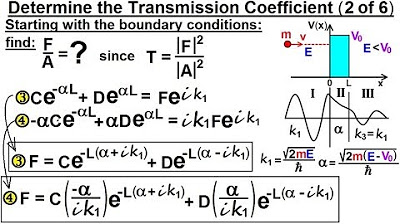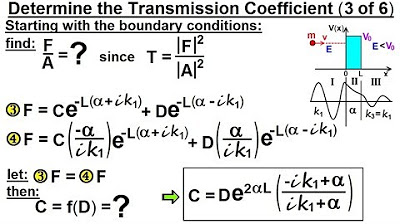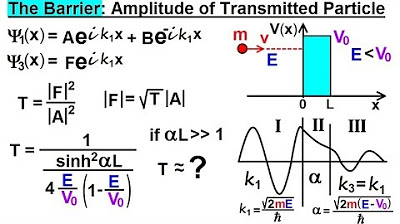Physics - Ch 66 Ch 4 Quantum Mechanics: Schrodinger Eqn (83 of 92) Transmission Coeff=? (1 of 6)
TLDRThe video script discusses the process of calculating the transmission coefficient, a measure of the probability of a particle passing through a barrier in quantum mechanics. It outlines the method of setting up boundary conditions and solving a system of equations to find the relationship between the amplitudes of waves in different regions. The process involves equating wave functions and their derivatives at the boundaries and solving for constants, leading to the determination of the transmission coefficient. The script sets the stage for a step-by-step guide, promising further explanation in subsequent videos.
Takeaways
- 📌 The transmission coefficient is used to calculate the probability of a particle passing through a barrier.
- 🔍 To apply the transmission coefficient, boundary conditions at both sides of the barrier must be identified.
- 🌐 The wave function of region one is set equal to the wave function of region two, and their derivatives are also set equal.
- 🔄 Similarly, the wave function and its derivative of region two are set equal to those of region three.
- 📈 This process results in four equations with five unknowns (a, b, c, d, and F), which allows for the solution of the transmission coefficient.
- 🚫 Since there's no reflection in region three, constants B and F are set to zero.
- 📌 By solving the first equation for B and substituting it into the second, we eliminate B and simplify the system.
- 📊 The wave number in region 1 (K1) and the exponential decay constant in region 2 (alpha) are crucial for the calculations.
- 🔢 The equation is further simplified by dividing terms and rearranging to express 'a' in terms of C and D.
- 🔍 The next step involves solving the remaining equations for F and setting them equal to each other to find the fraction F/a.
- 🎥 The detailed algebraic process is carried over to the next video, promising a step-by-step guide on how to proceed.
Q & A
What is the main purpose of using the transmission coefficient in quantum mechanics?
-The transmission coefficient is used to calculate the probability of a particle passing through a potential barrier, despite the potential being higher than the particle's energy.
What boundary conditions are necessary to solve for the transmission coefficient?
-The boundary conditions involve setting the wave function at the two sides of the barrier equal to each other and ensuring their derivatives are also equal at the interfaces of different regions.
How many equations are derived from the boundary conditions in the example given?
-Four equations are derived from the boundary conditions, one for each interface between regions one and two, and regions two and three.
What constants are involved in the equations to find the transmission coefficient?
-The constants involved are a, b, c, d, and F. Constants B and G are set to zero because there is no reflection in region three.
Why are B and G set to zero in the equations?
-B and G are set to zero because there are no particles moving to the left in region three to cause reflection, hence no incoming wave in that region.
What does the wave number K1 represent in the context of the script?
-The wave number K1 represents the wave number in both region 1 and region 3, which is used in the equations to describe the behavior of the wave function.
What is the significance of the exponential decay constant alpha in region 2?
-The exponential decay constant alpha represents the rate at which the wave function decays in region 2, where the potential is higher than the particle's energy, leading to an exponential decay of the wave function.
How is the constant B eliminated from the equations?
-B is eliminated by solving the first equation for B, expressing it as C plus D minus a, and then substituting this expression into the second equation, effectively removing B from the remaining equations.
What is the process to express the constant a in terms of C and D?
-By dividing both sides of the equation derived from the boundary conditions by 2 i K1 and rearranging the terms, a is expressed in terms of C and D, which helps in eliminating B and further solving for the transmission coefficient.
What is the next step after eliminating B from the equations?
-The next step is to solve the next two equations (equations 3 and 4) for F, setting them equal to each other, which will eventually lead to finding the fraction F over a.
How does the process of solving for the transmission coefficient involve the constants C and D?
-After eliminating B, the equation is rearranged to express a in terms of C and D. Further steps involve solving for F in terms of these constants, which is necessary to calculate the transmission coefficient as F/a.
Outlines
🌟 Quantum Mechanics: Solving for Transmission Coefficient
This paragraph introduces the process of calculating the transmission coefficient in quantum mechanics. It explains the need to find boundary conditions at both sides of a barrier and how to set up the wave function and its derivative to be equal across regions. The paragraph details the algebraic steps involved in solving the resulting system of equations to find the fraction F over a, which represents the amplitude of the wave in region three and is related to the transmission coefficient. This coefficient is used to determine the probability of a particle passing through a barrier. The explanation includes the introduction of constants a, B, C, D, and F, and the algebraic manipulation required to eliminate unknowns and solve for the transmission coefficient, which will be continued in the next video.
Mindmap
Keywords
💡Transmission Coefficient
💡Boundary Conditions
💡Wave Function
💡Quantum Mechanics
💡Potential Barrier
💡Amplitude
💡Algebraic Challenge
💡Constants
💡Exponential Decay
💡Solving Equations
💡Probability
Highlights
Exploring the transmission coefficient in quantum mechanics.
Setting up boundary conditions for a particle passing through a barrier.
Equating the wave function of region one to region two and their derivatives.
Similarly, equating the wave function and derivatives of region two to region three.
Deriving four equations from the boundary conditions to find the transmission coefficient.
The transmission coefficient relates the amplitude of the wave in region three to that in region one.
Squaring the ratio of F to a gives the transmission coefficient, which is related to the probability of a particle passing through the barrier.
The algebraic challenge of solving for the transmission coefficient is addressed step by step.
Constants a, b, c, and d are introduced, with F and G initially set to zero.
Elimination of constant B by solving the first equation for B.
Substituting B into the second equation to eliminate it and simplify the expression.
Resulting equation with terms involving the wave number in region 1 (K1) and the exponential decay constant (alpha) in region 2.
Further simplification leads to expressing 'a' in terms of C and D.
The next step involves solving the third and fourth equations for F to find the ratio F/a.
Equations 3 and 4 are solved simultaneously to find the fraction F/a, which is essential for the transmission coefficient.
The process requires additional work and will be continued in the next video.
The method described is crucial for understanding quantum tunneling and its applications.
Transcripts
Browse More Related Video

Physics - Ch 66 Ch 4 Quantum Mechanics: Schrodinger Eqn (84 of 92) Transmission Coeff=? (2 of 6)

Physics - Ch 66 Ch 4 Quantum Mechanics: Schrodinger Eqn (85 of 92) Transmission Coeff=? (3 of 6)

Physics - Ch 66 Ch 4 Quantum Mechanics: Schrodinger Eqn (78 of 92) The Barrier: Amplitude

Physics - Ch 66 Ch 4 Quantum Mechanics: Schrodinger Eqn (64 of 92) Transmission-Reflection (Q.M.)

Physics - Ch 66 Ch 4 Quantum Mechanics: Schrodinger Eqn (70 of 92) R=? T=? in terms of E & Vo

How to Solve Constant Coefficient Homogeneous Differential Equations
5.0 / 5 (0 votes)
Thanks for rating: